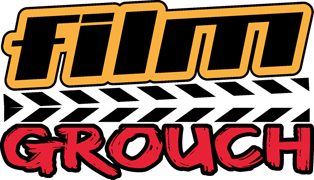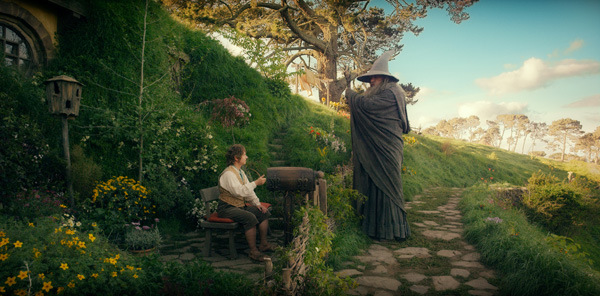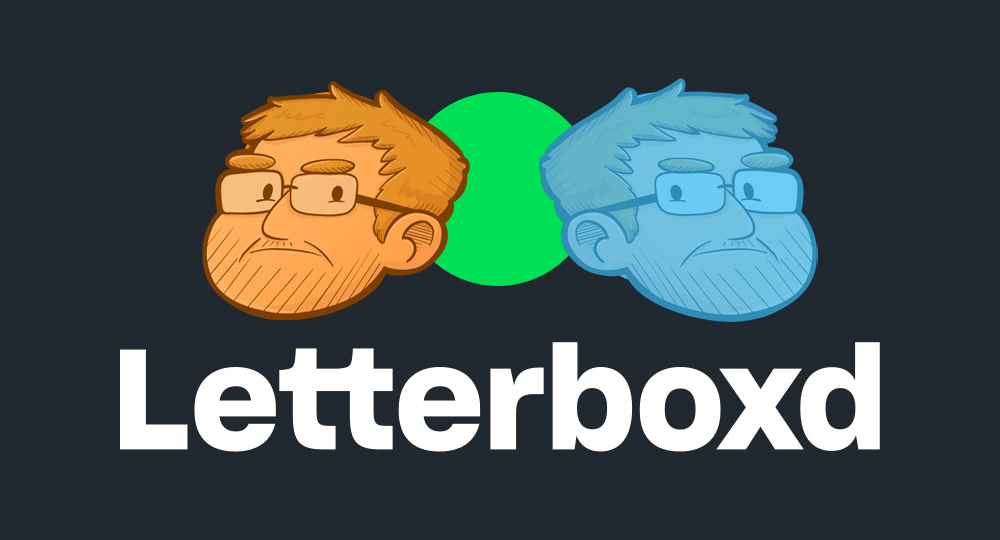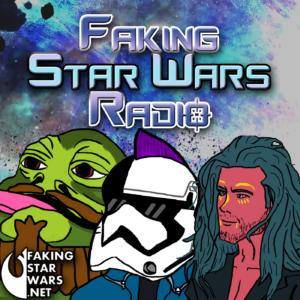Hi-ho, hi-ho, it’s off to Middle-earth we go!
The H-Bomb: Director Peter Jackson takes us back to the magical land of Middle-earth with The Hobbit: An Unexpected Journey. Set some 60 years before the events of The Lord of the Rings, it tells the story of young Bilbo Baggins (Martin Freeman), a simple, peaceful Hobbit who enjoys his simple, peaceful life in the Shire. Unfortunately for him, his perfectly ordered world is about to be flipped upside down by the arrival of the great wizard, Gandalf the Gray (Ian McKellen), and thirteen Dwarfs, led by the stoic Thorin (Richard Armitage). The homeland and wealth of the Dwarfs was stolen by a fierce dragon some time ago, and they are now embarking on a dangerous quest to take back both.
Gandalf believes that Bilbo can be of help on this adventure, and invites him to join them on their journey. At first, Bilbo wants nothing to do with it and tells him to go suck a duck. However, after paying the matter more thought, Bilbo changes his mind and decides to tag along, much to the chagrin of Thorin, who believes this friendly little creature has nothing to contribute, and sees him as nothing but a liability. Nevertheless, Bilbo comes with, and soon starts to think that maybe Thorin is right. Maybe he is in over his head, as it quickly becomes apparent that the road to the Dwarfs’ home is fraught with many perils: Orcs, Trolls, and other less-than-hospitable creatures that inhabit Middle-earth.
What’s worse, there’s a nasty Orc leader who is hellbent on hunting down Thorin in order to settle the score for an old war wound that the courageous dwarf inflicted on him years ago. Another danger they’ll have to contend with is the arrival of an evil spirit known as The Necromancer, whose very name alone implies that no good can come of meeting him. If they want to have even a prayer of succeeding in their quest, this merry band of vertically challenged heroes must band together and learn to trust each other… which is easier said than done.
As someone who truly admired the cinematic spectacle that Jackson created with the original Lord of the Rings trilogy, I really wanted to love The Hobbit: An Unexpected Journey. Alas, I didn’t. I certainly liked it, but there was just too much wrong with it to make me gush and grovel and kiss Peter Jackson’s pooder out of admiration. Let me start with an issue that everyone has brought up, and rightly so, the fact that Jackson shot it at a frame rate of 48 frames per second. Normal films are shot at 24 frames per second, so this is double the framage. On one hand, it gives the image a pristine level of clarity, but on the other hand, it causes the characters to move in an unnaturally fast manner. It looks as if the film put itself into fast-forward, and while I did eventually adjust to this frame rate, for much of the opening act, it was almost fatally distracting.
Another problem that the 48 frames per second creates for The Hobbit is that the picture is so crystal clear… too clear, actually. With the original Rings trilogy, I felt entirely immersed, like I had been whisked off to this other world. That didn’t happen this time, because, to me, the world now, thanks to the uber-clarity, just looks so completely artificial. Instead of a mystical Middle-earth, I see some nice shots of the New Zealand landscape with some obvious CGI added in, as well as costumes and sets that look way too clean to be real. You’d think that a decade’s worth of technological advances would’ve helped Jackson make an even more convincing Middle-earth, but it did just the opposite. It made it look like he shot the movie at Goddamn Disneyland.
Frame rates and other such technical jibber-jabber notwithstanding, I also have to lay into this Hobbit for its script. This new-found fad in Hollywood of making two movies out of one book has become increasingly irritating with each franchise that jumps on this bandwagon, and now we have The Hobbit, which is making three movies out of J.R.R. Tolkien’s one book, thus making it the worst offender of the lot. Seriously, what ever happened to the art of condensing? Not everything that’s in the book needs to be included in the film, they are two different mediums, after all. But Jackson and his stock company of screenwriters (Philippa Boyens, Fran Walsh, and guest writer Guillermo del Toro) seem to feel differently, hence An Unexpected Journey, running at nearly three hours, feels awfully padded in places. This is most evident in the scene towards the beginning where all the Dwarfs gather at Bilbo’s home. Despite some of their amusing antics, such as raiding Bilbo’s pantry and playing catch with his dishes, the sequence gets bogged down in a ton of exposition and goes on for what feels like an eternity. Also, unless I missed something, there was nothing that anyone said or did to talk Bilbo into going on the quest with the dwarfs, he just seemed to wake up in the morning and change his mind.
What also seemed unnecessary was a stop at the Elf home of Rivvendell, where the sole reason for including it, aside from delivering even more tiring exposition, is to provide fan-service cameos for the likes of Cate Blanchett, Hugo Weaving, and Christopher Lee. I can’t bitch too much about this, as I certainly didn’t mind seeing these characters again, but the scene, in retrospect, is kind of pointless. Another bit that should have been saved for the DVD extended edition was a side diversion in which our heroes encounter three giant, horse eating trolls. It’s certainly a funny scene, and doesn’t really hurt the movie in any sense, but it goes on for too long and, again, doesn’t serve much of a purpose other than to pile more minutes onto the film’s running time.
If there is one inclusion that does harm the film, it has to be the appearance of a dingy, disgusting nature wizard with ginger hair caked in dried, crusted bird crap and a rabbit-drawn sled. Holy hobbit balls is this guy obnoxious! Some out there have already begun making comparisons with an infamously annoying character from another prequel trilogy, but I wouldn’t go that far, as he doesn’t have enough screen time to be as annoying as that other character. Still, he does hang around just long enough to make me wish that something very, very bad would happen to him.
I know it seems as though I am really ripping this poor Hobbit limb from limb, but I’m not, since that’s pretty much the end of my gripes. Things do pick up substantially in the second half of the film, with some truly creative action scenes (one aspect that is an improvement over the Rings trilogy), including a fight between two mountains, as well as a thrilling escape where Gandalf and the Dwarfs have to do battle with some hideous goblin king who has what looks like a giant testicle hanging off of his chin. These scenes truly showcased Jackson’s immense talents as a filmmaker, and looked absolutely stunning in 3-D (this is one where the 3-D is actually worth a damn).
My personal favorite scene, one that will be a favorite for many, I’m sure, is the one in which Bilbo encounters my favorite character from the original trilogy, a sneaky little rodent whose mind and body have been destroyed by a certain “precious.” I, of course, am speaking of none other than Golem (played, once again, by the fantastic Andy Serkis), whose war-of-riddles with Bilbo is an absolute show stopper, and serves as a perfect set up for the Rings trilogy. A definite highlight of the show, this sequence makes me yearn for a movie entirely about Golem.
Not only is Serkis terrific, but so is the entire cast. In fact, I would go as far as to argue that the performances are The Hobbit’s greatest virtue, as everyone carries their weight and then some, even though most of the Dwarfs are given little to do other than look funny and crack the occasional joke. Freeman brings a goofy charm to Bilbo, making him an entirely sympathetic protagonist, even when he behaves timidly, which is pretty much most of the time. As a lead, I much prefer him to Elijah Wood’s Frodo (who does appear briefly), as he is far quirkier and overall has a lot more personality. As Dwarf leader Thorin, Armitage conveys a great sense of strength and authority, despite the character’s limited physical stature. When he steps forth to lead his motley crew of little people, I found him more than believable. He is the Viggo Mortensen of this new trilogy.
Though Armitage and Freeman are great, the best of the lead performers is easily McKellan, who slips right back into the role of Gandalf the Gray like he never left (he literally looks exactly the same as he did a decade ago), and just owns every scene he’s in. Whether he’s using his wizard powers to whoop some Orc ass, or simply sitting off by himself, lost in his thoughts and puffing on his pipe, he portrays Gandalf with dignity, intelligence, and a sly sense of humor. He is the glue that holds this movie together.
All in all, The Hobbit is a fun film, if not a somewhat flawed one. My criticisms may cause legions of fanboys to fling their flaming arrows of nerd rage at me, as criticizing anything Lord of the Rings-related can be tantamount to insulting ones religion, but I just could not let Jackson’s unfortunate technical and script decisions pass without critique. But despite its shortcomings, The Hobbit: An Unexpected Journey is a thrilling, solid fantasy film, and I do recommend it. It’s just that when it comes to matching the amazing heights of the original trilogy, it falls somewhat short of expectations.




